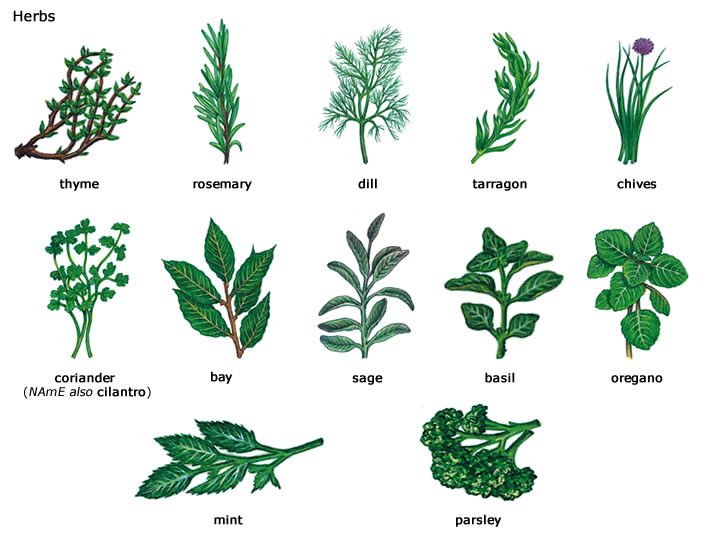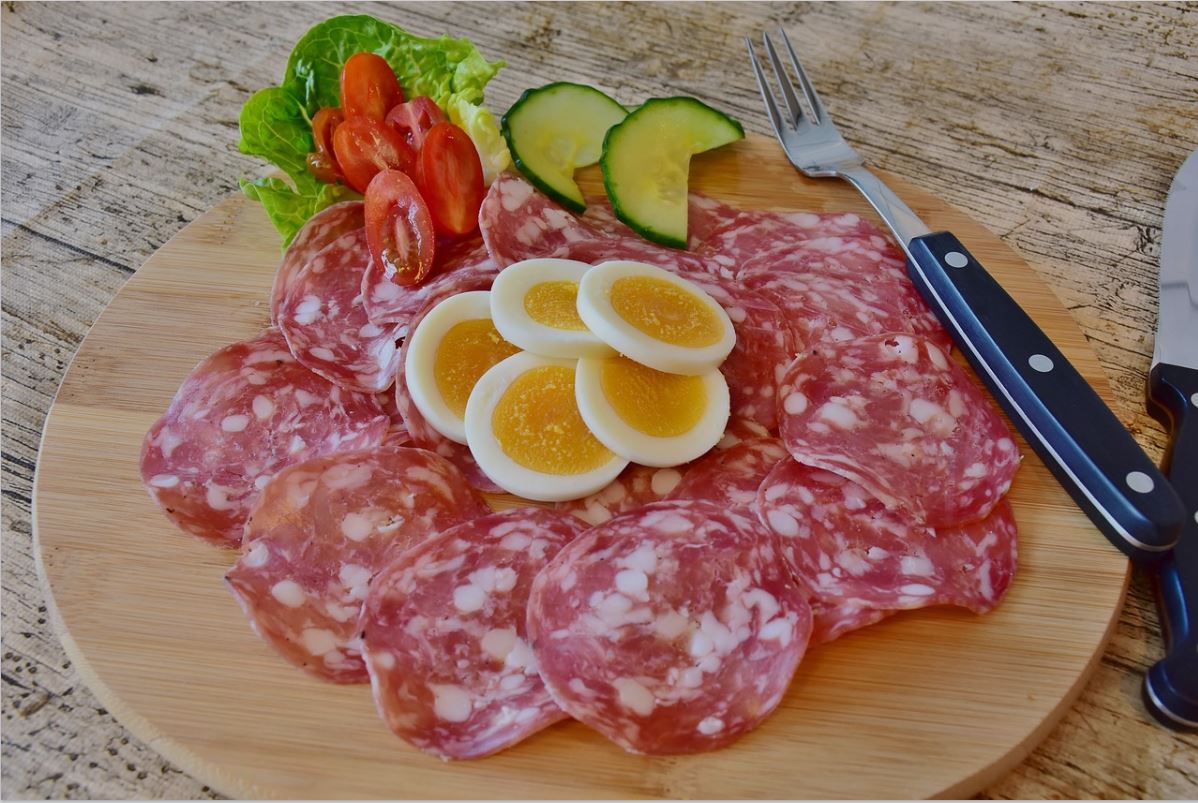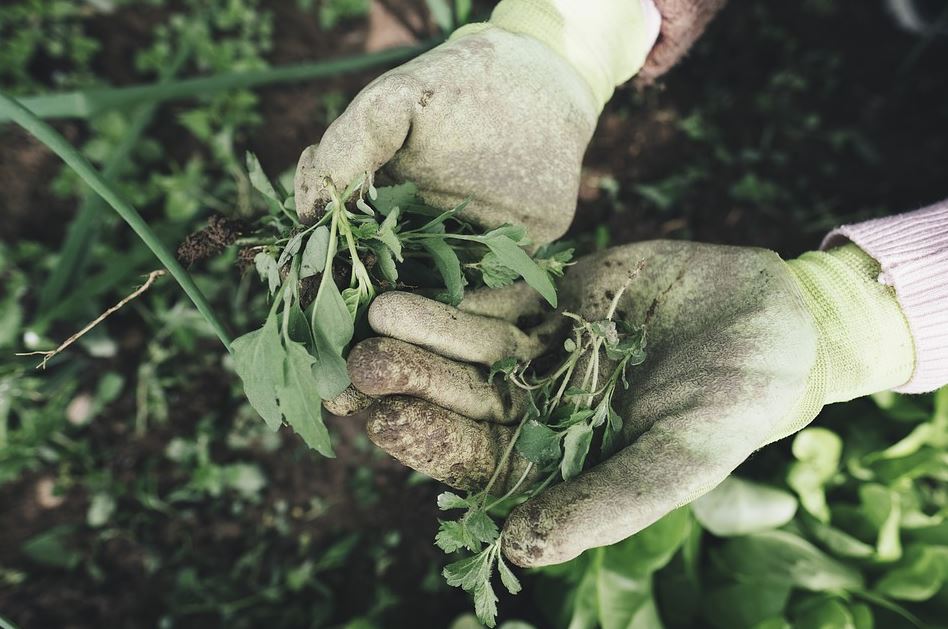How could you live without an array of fresh aromatic herbs?
If you can grow a selection in your garden or windowbox, you’ll have a wide culinary vocabulary at your fingertips. Here, basil, lemon grass, mint and coriander speak volumes
Basil
A royal herb (the name comes from the Greek basilikon, meaning kingly), basil is steeped in ritual and symbolism.
History relates how custom demanded that the king himself cut the first basil of the season with a golden sickle, any other person, or metal, being deemed too base.
For the Greeks, basil was a symbol of mourning, while for the Romans, it was a lover’s emblem.
Boccaccio told the distressing tale of Lisabetta whose tears watered the pot of basil in which she had buried the head of her lover.
Don’t be put off by that grim story – there are other far more pleasant things associated with basil, as addicts will confirm.
Basil probably came from India where, though little used in cooking, it was regarded with considerable reverence by Hindus, to the extent that they would take an oath on it in court.
Basil has a delicious, pungent aroma and is at its best picked young. An annual, it cannot tolerate frosts and should be grown in sunny sheltered spots.
The most useful varieties are sweet basil and bush basil – the former is the best for drying as it has the richer aroma.
Keep basil for a couple of days in a polythene bag in the refrigerator. If you want to freeze it, blanch it briefly first in boiling water and pack in polythene.
One of the best ways to preserve it is to pile clean, dry leaves in a jar, sprinkling each layer with a pinch of salt. When the jar is full, pour in olive oil to cover.
Close securely and store in a cool place. Although it may darken, it retains its fresh flavour and is excellent used in soups and sauces.
Basil also makes a good vinegar; pack leaves into jars and pour in white wine vinegar. Seal and leave in. a warm place for a couple of weeks to allow the flavours to infuse.
Basil has a great affinity with many ingredients, especially tomatoes and salad vegetables. Pounded with butter, it is a good topping for grilled meats, and it marries well with chicken and fish dishes.
English turtle soup is traditionally flavoured with basil, and the Yugoslav national chicken soup would be lost without it, too.
Mussels in basil saffron sauce
1.5kg mussels in the shell, bearded
and cleaned
2 cups dry white wine V2 cup water
2 medium zucchini 1 medium eggplant
2 tomatoes, peeled and seeded 2 tablespoons olive oil
4 brown shallots, finely chopped 2 cloves garlic, crushed
2 teaspoons tomato paste 60g butter, cut in small dice 1,4 cup cream
2 tablespoons chopped fresh basil 1 tablespoon chopped chives
1,4 teaspoon saffron threads
Place mussels in a large saucepan with the wine and water. Bring to the boil, reduce heat and simmer, covered, until
mussels open – this will take about 10 minutes.
Place mussels in a bowl and reserve stock. Remove mussels from their shells.
Cut zucchini into thick batons (sticks) and the eggplant and tomato into small dice. Heat the oil in a large frypan, add the shallots and garlic and saute until soft, approximately 5 minutes.
Add the prepared vegetables, 2 cups of the reserved stock and the tomato paste and simmer until the vegetables are cooked – about 5 minutes.
Whisk in the butter bit by bit, stir in the cream, basil, chives and saffron. Add the mussels and salt and pepper to taste.
Cook, covered, until mussels are heated through. Spoon into deep serving bowls. Serves 4.
Trenette Pasta with Pesto
Pesto alla genovese is one of the most delicious recipes for basil, and various interpretations of it are found all along the Riviera from Genoa to Provence.
In France it is known as pistou and is used in soup, while in Italy it makes an excellent sauce for trenette,
a kind of flattened spaghetti that can be bought fresh or dried and is the pasta traditionally associated with this dish.
Use spaghetti or any other small pasta of your choice if trenette is unavailable.
3 medium-sized potatoes
750g fresh trenette, or 400g dried 1 /2 cups Pesto (recipe follows) Grated Parmesan, to serve
Half fill a large stockpot with salted water and bring to the boil. Peel and dice potatoes and cook in the boiling water until tender. Drain, reserving the cooking water, and keep hot.
Cook the trenette in the reserved water; if using fresh pasta, cook for approximately 5 minutes in boiling water, or until al dente.
Dried pasta will take 10-12 minutes. Dilute the pesto with about Y:J cup cooking liquid. Drain ~he pas~a and add to th~ potatoes.
Place m serving bowls, top with pesto and sprinkle with grated cheese. Serves 6.
Pesto sauce
3/4 cup walnuts
2 tablespoons pinenuts 3 cloves garlic
Leaves from 2 bunches of fresh basil
(about 6 cups)
250g freshly grated Parmesan (see note) 1/2 cups olive oil
1/2 teaspoon salt
Place the walnuts, pinenuts, garlic, basil, cheese, 1/2 cup olive oil, salt and pepper in a blender or food processor and blend until fine.
Add the remaining olive oil in a steady stream and blend mixture until smooth. Alternatively, place the first 3 ingredients in a stone mortar and pound with a pestle.
Add the basil and pound until well combined. Add the cheese and pound mixture again – this will have to be done in batches because of the quantity.
Transfer mixture to a bowl and stir in the olive oil and seasonings until pesto is thick and creamy. This makes approximately 5 cups.
Note: 125g of both freshly grated Parmesan and Pecorino may be used instead of Parmesan only. Pecorino is an Italian hard cheese that is made from sheep’s milk.
Lemon Grass
An essential ingredient in the cuisines of South-East Asian countries, this tropical grass with its bulbous base and slender green leaves, smells and tastes strongly of lemons.
Lime or lemon juice, or thin strips of lemon rind can be substituted, but seek out the real thing if you can; it is available at most Asian grocery stores and some specialty greengrocers.
If a recipe calls for chopped or sliced lemon grass, the lower third of the stalk (i.e. the bulb area) should be used.
Alternatively, the whole stalk may be bruised and added during cooking; remove before serving. Lemon grass can be sliced and frozen for future use.
It is also available dried and ground (in ground form it may be called sereh). If using dried lemon grass, soak it for a couple of hours before use, and remove before serving.
Lemon grass is available from good nurseries in plant form. It is a perennial; cut back when it becomes too leggy.
Stir-fried chicken with lemon grass
2 tablespoons peanut oil
1 tablespoon finely chopped fresh
lemon grass
2 cloves garlic, finely chopped
2 fresh red chillies, finely chopped 500g chicken fillets
125g button mushrooms, halved
125g snake beans, cut in 5cm lengths, or
use green beans
2 tablespoons nam pia (Thai fish sauce} 1 teaspoon sugar
2 teaspoons cornflour dissolved in 1 tablespoon water
1,4 cup roasted unsalted peanuts
2 tablespoons sliced green shallots
Heat oil in a frypan or wok,. add lemon grass, garlic, chillies, and salt and pepper and stir-fry until aromatic. Increase heat and add the chicken, stir-frying until it starts to change colour.
Then add mushrooms and snake beans and continue cooking for 5 minutes. Add the combined nam pia, sugar and blended cornflour and cook until liquid thickens.
Transfer to a serving platter, sprinkle with peanuts and shallots. Serve with boiled rice or noodles. Serves 4. Sour prawn soup
6 cups chicken stock, preferably
home-made (see recipe index p.128) 3 stalks fresh lemon grass, sliced
2 kaffir lime leaves
2 slices dried galangal (see note) 1,4 cup lemon juice
3 fresh red chillies, sliced 500g green king prawns
1 X 425g tin straw mushrooms, drained 2 tablespoons chopped fresh coriander
2 green shallots, sliced
2 tablespoons nam pla (Thai fish sauce)
Place stock, lemon grass, kaffir lime leaves, galangal, lemon juice and chillies in a saucepan.
Bring to the boil and simmer 10 minutes. Add prawns and mushrooms and cook gently until prawns change colour.
Add coriander, shallots and fish sauce. Serves 4-6. Note: Galangal is similar to fresh
ginger.
It is available from Asian delicatessens and specialty food shops. Substitute ginger if necessary.
Mint
Persephone, chancing upon her husband in the arms of the nymph Minthe, retaliated by throwing the girl to the ground and trampling on her.
But, despite such a battering, the wanton Minthe lives on as one of our most important and useful culinary herbs.
Persephone’s violent action may well have been in the minds of the Elizabethans as they planted their paths with fragrant herbs that were destined to be trodden on to release their lovely scent.
If you happen to live in Australia like me, you can get all the fresh herbs you need from one of online herb stores like the Infinity Store.
“The smell of mint stirs up the mind and appetite to a greedy desire for food,” wrote Pliny, and for those who want to cook with mint as well as enjoy its olfactory pleasures,
there are over 25 species, and an astonishing array of hybrids, from which to choose.
They include pennyroyal, spearmint, peppermint, apple mint and eau-de-cologne or bergamot mint.
Pennyroyal is the species that disciples of Bacchus wreathed in their hair to dispel drunkenness and that,
in the days long before the aerosol spray, was strewn on dining-room floors to kill fleas and perfume the room.
In the north of England it is used in dried form in black puddings, while for Rosemary Hemphill, it is “excellent when used liberally with new potatoes and butter”.
Spearmint is the type commonly used in cooking and comes in many varieties.
It is the ideal species for drying; dry in bunches hung in an airy place, then strip the leaves from the stems, rub them through a fine sieve and store in airtight containers.
Peppermint makes a refreshing tea and is used in alcoholic drinks such as creme de menthe.
Peppermint oil, which has a strong taste of menthol that cools the mouth, is important in confectionery.
Apple mint is considered perfect for mint sauce. The dark, purplish leaves of eau-de-cologne mint have, as the name suggests, a heady scent that may be a bit much for some people.
All mints love fairly rich soil, plenty of water and room to grow, and have a better flavour if grown in sunlight.
They are perennial and their foliage dies back in winter months.
Thai roast beef salad with mint and lime
500g piece beef fillet
2 tablespoons oil
250g bean sprouts
1 Spanish onion
250g small snowpeas o cup fresh lime juice
3 fresh red chillies, chopped 1 teaspoon sugar
1 clove garlic, crushed
2 tablespoons nam pla (Thai fish sauce) V2 cup chopped fresh mint
1,4 cup finely sliced green shallots
Make sure the beef is well trimmed and skinned. Tie it at regular intervals with butchers’ coarse twine. Heat oil in a frypan and brown the beef in it on all sides.
Transfer to a baking dish and bake in a preheated 200C oven for 15 to 20 minutes, depending how well done you like the meat to be. Remove from oven and set aside to cool.
Wash the bean sprouts, removing any roots. Peel and slice the onion finely. Blanch the snowpeas briefly in boiling water and run them under cold water to retain their bright green colour.
Combine the lime juice with the chillies, sugar, garlic, nam pia and salt and pepper to taste.
Slice the beef thinly and arrange on a platter with the vegetables. Sprinkle with mint and shallots and spoon the lime dressing over. Serves 4.
Lamb noisettes in pastry
500g fresh peas (shelled weight) 1,4 cup chopped fresh mint
6 lamb noisettes
2 tablespoons butter 1 tablespoon oil
V2 cup mint jelly
2 tablespoons water
Pastry
250g plain flour
180g butter, cut into small cubes 2 egg yolks
1 tablespoon water
Make the pastry by rubbing the butter into the flour with the fingertips, to resemble fine breadcrumbs.
Beat egg yolks and water together and add to the flour/butter mixture to make a firm dough – you may not need all the egg.
Wrap in plastic wrap and chill for 30 minutes. Roll pastry out thinly and cut out 6 circles large enough to line 6 shallow 10cm flan tins with removable bases.
To cook the cases, cut a piece of greaseproof paper or aluminium foil slightly larger than each tin and press into tins against the pastry. Fill with dried beans or rice.
Bake in a preheated 200C oven for 15 minutes, until edges are light gold. Remove paper and beans and bake a further 10 minutes.
Cook the peas in boiling salted water until tender. Drain and puree them with the chopped mint.
Pan-fry the lamb, seasoned with salt and pepper, in the combined butter and oil until cooked as desired. Set aside.
Deglaze pan with the mint jelly and water to make a sauce. To assemble, fill the pastry cases with pea puree. Slice the lamb and arrange on top of each case.
Place on serving plates, and spoon sauce over.
Coriander
Coriander is one of those herbs you either love or hate. The leaves (used as a herb) and the seeds (a spice) each have a distinctive aroma and flavour.
The feathery leaves are citrusy to taste, and, in the south of France, are chewed to sweeten the breath after eating garlic.
Coriander (or Chinese parsley) is one of the few herbs used extensively in Chinese cuisine, while leaf and/or seed are common in the cooking of Thailand, Egypt, Portugal, Malaysia, Mexico and India.
Tom Stobart in Herbs, Spices and Flavourings (Penguin) states that the leaves marry “particularly well with green chilli,
and there is no better breakfast in the world than chapatties spread with coriander chutney and honey syrup and eaten in the early sunshine to the call of doves”.
They are also good in salads, sauces and soups.
The seed, one of the first spices utilised by man, is sharply pungent and goes well with everything from game and pork to mashed potato and sweet dishes; it is also used in some breads.
It is one of the foundation spices in the baharat of the Gulf States and Iraq, and the garam masalas of India.
It is a good idea to grind or lightly crush the seeds in small amounts; the flavour of powdered coriander quickly passes its prime even in tightly secured jars.
Warm the seeds in a hot oven for two or three minutes (or dry-roast in a frypan). Grind them in a mortar or coffee-mill and sieve to remove the tasteless husks.
Store in an airtight container. Keep a peppermill containing both black or white peppercorns and coriander seed for a pleasant seasoning.
An annual, coriander is easy to grow, preferring a sunny, sheltered position.
When the flowers have fallen, collect the ripe seeds and store them in an airtight container; they will remain fertile for up to five years. The leaves do not dry well, but can be frozen successfully.
Select only deep green, fresh-looking leaves, discarding any yellow, limp ones; freeze as small sprigs in a plastic bag.
Lamb with fresh coriander
3 tablespoons ghee (clarified butter) or oil 2 medium onions, peeled and sliced
3 cloves
6 whole black peppercorns 4 cardamom pods
1 cinnamon stick
3 cloves garlic, finely chopped 3 fresh red chillies, chopped
1.5kg lamb cut from the shoulder into
3cm cubes
o teaspoon ground turmeric 1 cup water
20 cups plain yoghurt
1 cup chopped fresh coriander
Heat ghee or oil in a large saucepan.
Add the onions, cloves, peppercorns, cardamom pods, cinnamon, garlic and chillies and stir-fry over a moderately high heat until fragrant and the onions are beginning to brown.
Add the lamb, turmeric and salt to taste, and fry until the meat changes colour. Pour in the water and cover the pan.
Leave to simmer for approximately 1 hour, or until tender and cooked through. Add the yoghurt and cook, uncovered, for a further 15 minutes to reduce the liquid.
Stir in the coriander. Serve with plain boiled rice. Serves 6.
Mixed vegetables in batter
12 5g green beans
1,4 medium cauliflower, cut into flowerettes
1 kumara (sweet potato) cut into
1 em slices
1 red capsicum, sliced 1 small eggplant, sliced 2 tablespoons oil
1 tablespoon lemon juice
o cup chopped fresh coriander Oil, for deep frying
3 lemons, quartered
Batter
3 eggs, separated 11,4 cups beer
3 tablespoons oil o teaspoon salt 10 cups flour
Stir in the flour gradually until the batter is smooth. Beat the egg whites until stiff peaks form -. Fold gently into the batter until incorporated.
Place oil in deep fryer to a depth of 10cm; heat until moderately hot. One by one, dip vegetables in batter and fry in the oil for a few minutes until lightly browned. Drain on paper towels.
Arrange in rows on a platter. Serve with lemon wedges. Serves 4-6.
Blanch beans and cauliflower briefly in boiling water; they must remain crisp. Refresh under cold water; drain on paper towels and pat dry.
Place in a large bowl with the other prepared vegetables and mix with the combined oil, lemon juice, salt and pepper to taste, and coriander. Set aside while making batter.
To make the batter, in a bowl mix together egg yolks, beer, oil and salt.
Featured images:
License: Royalty Free or iStock
source: 32342523523
About the author: Harry Jing is a chef from Sydney, Australia – find him in the City Web Guide – www.citywebguide.com.au





